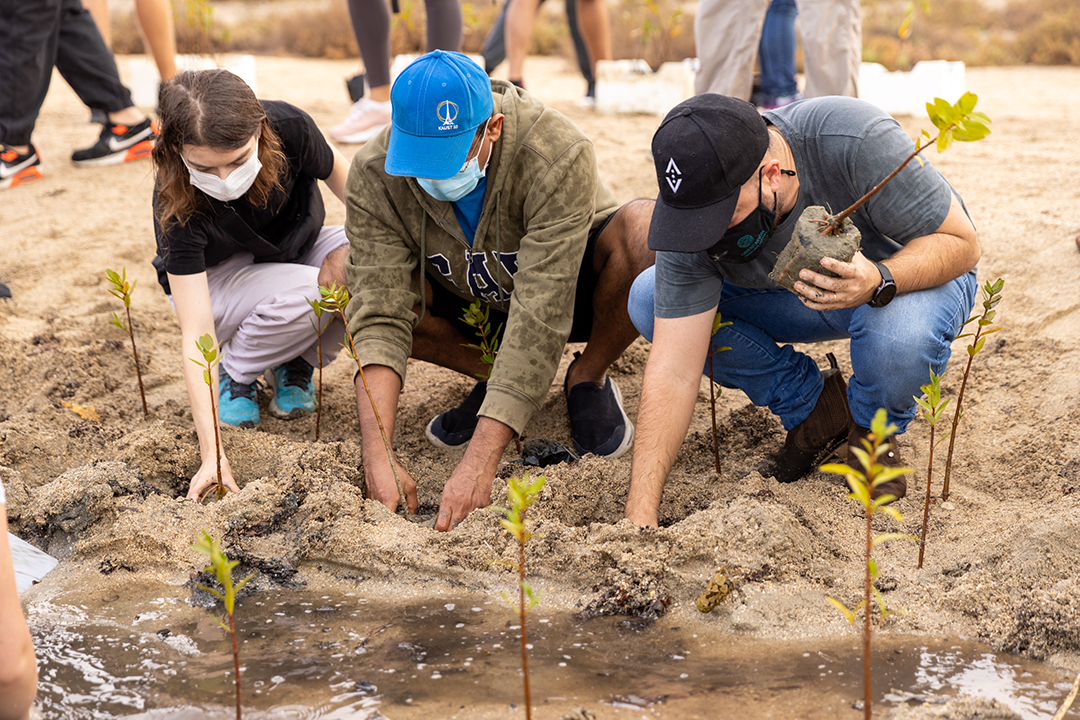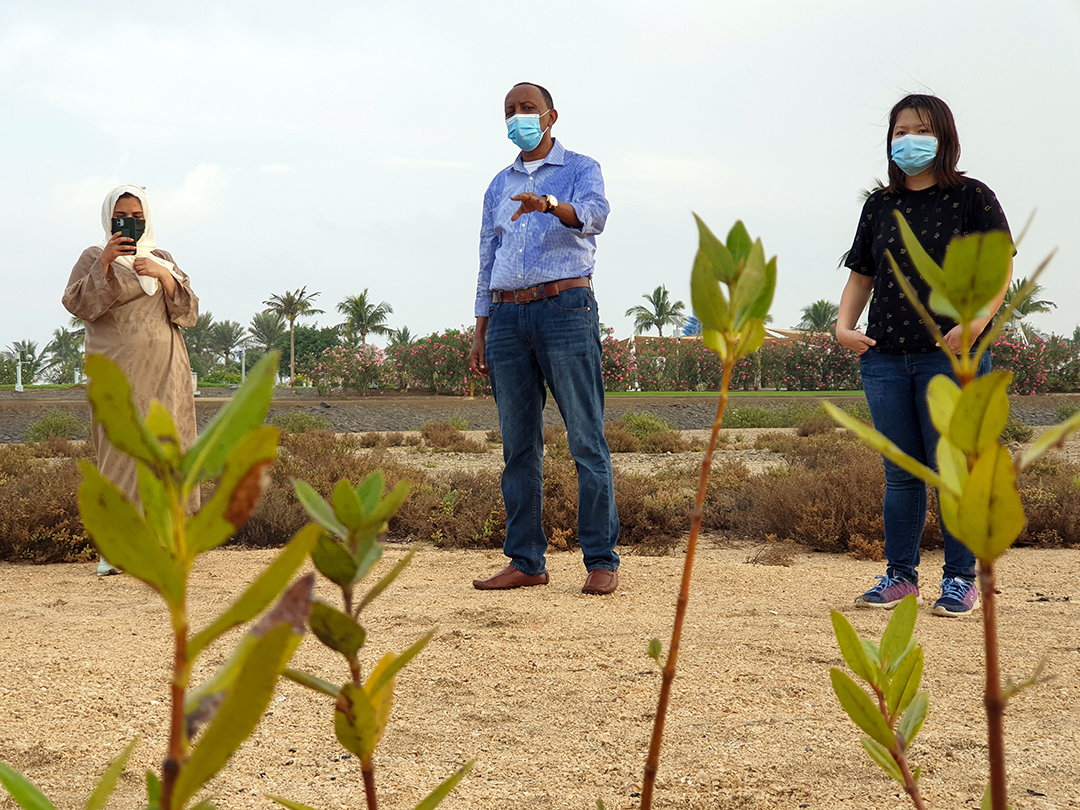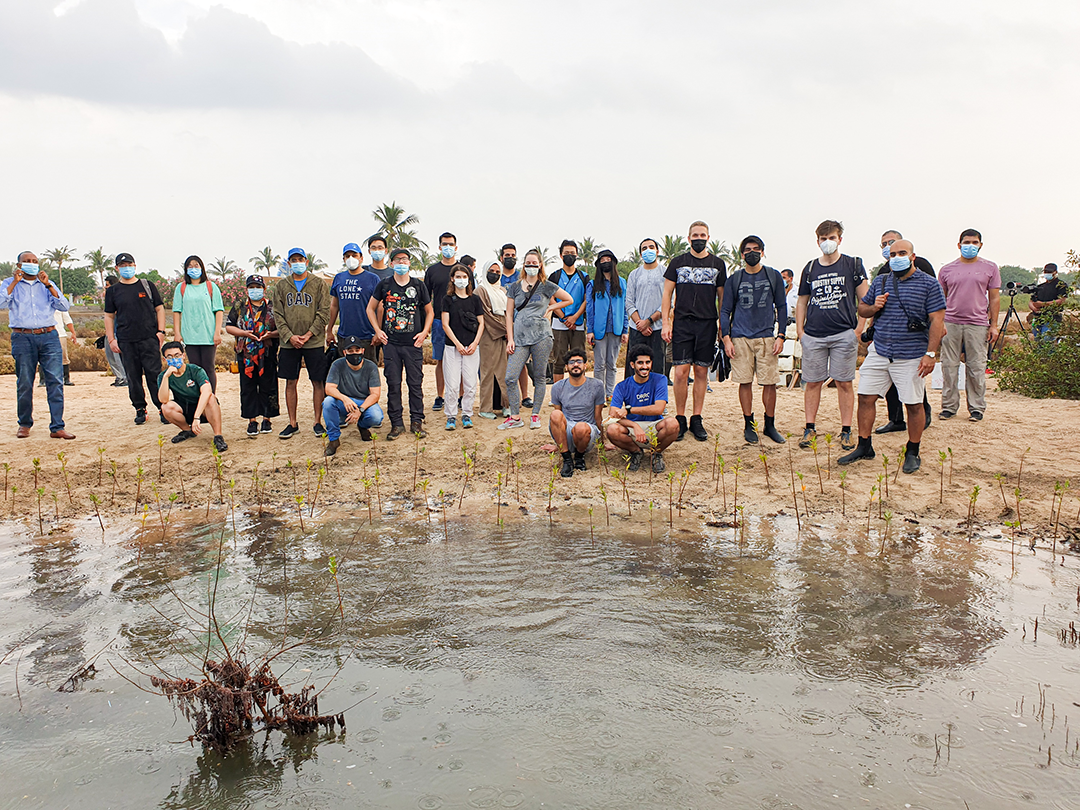Carbon offsetting: Making the most of mangroves

KAUST community members plant mangrove trees in the University's coastal wetlands.
Mangroves have stood the test of time. Able to live in water up to 100 times more saline than other plants can tolerate, they have thrived in some of the harshest environmental conditions for millions of years.
During this time, mangroves have been able to set up shop around the world, their fruits, seeds and saplings able to float for months before taking root; within a decade, one seed can give rise to an entire colony that, in turn, can create new land and habitats in and around it.
These attributes make mangroves invaluable ecosystems to protect.
With one "foot" on land and one in the water, these amphibious plants provide food and shelter for many animals, including birds, crabs, lizards, shrimp, mollusks, stingrays, snails and fish.
Blue carbon sinks
Mangroves are increasingly being recognized as important players in the fight against climate change.
"KAUST is home to a
thriving mangrove forest spanning more than 110 hectares, including a Nature Conservation Area," said Dr. Mohamed Omar, Environmental Protection Manager in the KAUST Health, Safety and Environment (HSE) department.

Dr. Mohamed Omar, KAUST HSE Environmental Protection Manager (center) and Professor Peiying Hong (right) speaking as part of the 2022 Winter Enrichment Program ever at the KAUST Nature Conservation Area.
"Compared to other terrestrial forests, the extensive network of mangrove roots provides an ample opportunity for carbon to sink."
KAUST Professor Dr. Carlos Duarte added, "Mangrove forests rank among the most intense carbon sinks in the biosphere, locking much more carbon into their soils than tropical forests. However, when disturbed, the carbon in the soils may be emitted as CO2, so there is opportunity for climate benefits in both avoiding mangrove losses and restoring lost mangroves."
Mangroves are referred to as blue carbon sinks because of their association with coastal areas; "blue" for water, in contrast to "green" carbon that is linked with land-based trees.
Offsetting carbon during the 2022 Winter Enrichment Program
Although mangrove forest conservation and enhancement has been a key part of KAUST since its early days, the planting of mangroves in the winter of 2022 in KAUST's Nature Conservation Area was a project initiated to raise awareness of the negative environmental impact associated with travel-related carbon emissions.
As part of KAUST's
2022 Winter Enrichment Program (WEP), Event Chair and KAUST Professor Dr. Peiying Hong approached the HSE Department to discuss ways of collaborating to make the event more sustainable.

Group of participants at the 2022 Winter Enrichment Program (WEP) mangrove tree planting event.
"Every year, WEP aims to enrich our students' learning experience by inviting globally renowned speakers to share their perspectives in person at KAUST. This incurs a large carbon dioxide footprint," Hong explained. "The WEP theme for 2022 was resilience, and a main focal message of the program was to explore ways to mitigate various tipping points, such as climate change and exhibit resilience. Hence, we wanted to stay true to our theme."
Indeed, the HSE team estimated that this year's WEP speakers covered about 200,000 kilometers in long-distance travel. Having calculated their carbon emissions, the WEP team, in collaboration with HSE and Facilities Management (horticulture), decided to plant more than 200 mangrove plants to not only offset their emissions over time, but also raise awareness about their carbon capture abilities.
Key learnings and progress
In the years since KAUST has become a custodian of mangroves, some important discoveries have been made.
Duarte said, "We discovered that Red Sea mangroves, which rank toward the low end in terms of organic carbon sequestration in their soils and biomass, activate an additional mechanism — an alkalinity emission from dissolution of the carbonate in the bedrock they grow on, which we estimate amplifies their carbon removal capacity by 23 times."
KAUST's mangrove conservation efforts have also revealed how quickly and effectively mangrove colonies can expand when preserved properly.
"Our mangrove forest has grown around 45 percent between 2005 and 2020," Omar said. "This remarkable growth is a combination of natural colonization, replantation efforts, and environmental policy intervention."
Looking ahead
Mangrove planting and restoration projects represent a cost-effective way of boosting carbon capture capacity, especially if planned and executed properly, as has been the case at KAUST so far.
Hong said, "The planting of mangroves in this instance is more beneficial than planting land-based trees, which require freshwater irrigation. Mangroves do not need irrigation water since they are planted directly in the coastal areas of the sea."
Already part of the natural landscape of many communities around the world, mangroves serve as a non-invasive carbon mitigation measure, a nature-based solution that has an important role to play in the future.
"Mangroves are definitely one of the ways to achieve our carbon mitigation goals, not simply because they sequester carbon, but also because they offer huge benefits for coastal protection and many other advantages, including fishery enhancement," Duarte said. "Over the past decade, the level of awareness on blue carbon, and specifically the role of mangroves, has grown. This education must continue, both at policymaker and public levels to boost engagement and uptake of mangrove projects."
Related content

